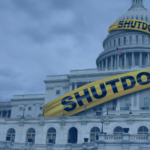
There have been 14 government shutdowns since 1980. If Congress does not agree on a budget by Oct. 1, the start of the federal fiscal year for 2024 (FY 2024), a 15th shutdown will ensue, impacting the recycled materials industry both directly and indirectly.
“We are operating in a different mode than previous shutdowns,” said Richard Gold, partner at Holland & Knight LLP, during a members-only ReMA webinar. “Republicans in the House are not arguing about specific budget items…there are no clear goals.”
Federal government shutdowns have a wide range of impacts, the severity of which can depend on the shutdown’s length, and what appropriations bills and continuing resolutions (CRs) have been passed. Gold explained that much of the federal government is funded by 12 annual appropriations bills. If appropriations bills have not been enacted before the start of the federal fiscal year or a temporary funding measure — known as a continuing resolution (CR) — has not been enacted, a gap (or lapse) in appropriations will occur. As of this writing, none of the FY 2024 appropriations bills have been enacted, and there is no agreement on a short-term CR.
“It’s not odd for some appropriations bills to be voted on and passed in the next year. What makes this different is that the House has not passed any,” said former U.S. Rep. Tom Davis during the webinar. “Nobody knows how long this will play out but I think it will last weeks, not days.”
Agencies have submitted plans to the Office of Management and Budget where they outlined who is essential and what functions will continue. Past acts, like the Antideficiency Act, contain forward funding for some agencies, which would temporarily mitigate some of the effects of a shutdown.
A shutdown of a few days may be an annoyance, but effects would be minimal. “Once you get to two or three weeks, the gears start to seize up,” said Gold. Some initial impacts include delays in permitting with the Environmental Protection Agency (EPA) and Occupational Safety and Health Administration (OSHA). Customs and trade could see increased processing time due to a cut in manpower. The longer the shutdown carries on for, the greater the impact.
Both Gold and Davis spoke on the cascading effects a shutdown could have. For example, delays in permitting lead to softer manufacturing (already reporting less than stellar numbers for the past six weeks) and can lead to lower chances of the economy reaching a soft landing. This would be in addition to all the current pressures already acting on the economy including labor strikes, mid-size banks experiencing softness due to commercial real estate and oil forecasted to reach $100 a barrel in the next few weeks.
“They might have to find out that a government shutdown won’t give them the leverage they think it will,” said Davis.

There have been 14 government shutdowns since 1980. If Congress does not agree on a...